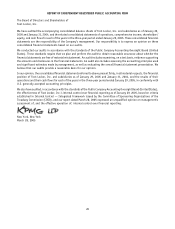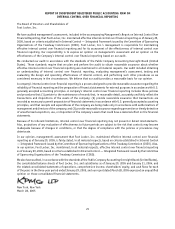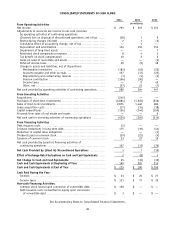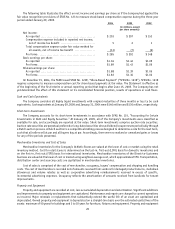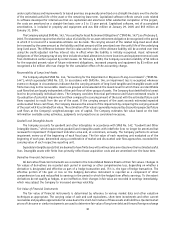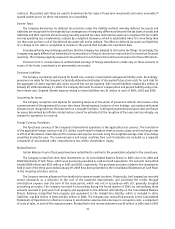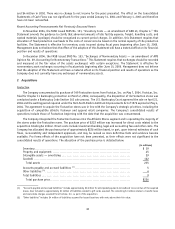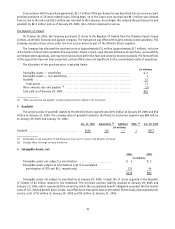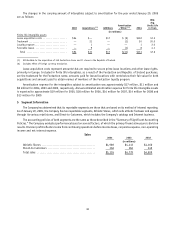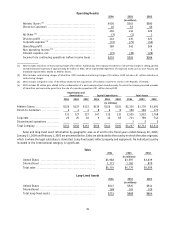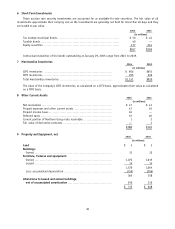Foot Locker 2004 Annual Report Download - page 46
Download and view the complete annual report
Please find page 46 of the 2004 Foot Locker annual report below. You can navigate through the pages in the report by either clicking on the pages listed below, or by using the keyword search tool below to find specific information within the annual report.under capital leases and improvements to leased premises are generally amortized on a straight-line basis over the shorter
of the estimated useful life of the asset or the remaining lease term. Capitalized software reflects certain costs related
to software developed for internal use that are capitalized and amortized. After substantial completion of the project,
the costs are amortized on a straight-line basis overa2to11year period. Capitalized software, net of accumulated
amortization, is included in property and equipment and was $50 million at January 29, 2005 and $55 million at
January 31, 2004.
The Company adopted SFAS No. 143, “Accounting for Asset Retirement Obligations” (“SFAS No. 143”) as of February 2,
2003. The statement requires that the fair value of a liability for an asset retirement obligation be recognized in the period
in which it is incurred if a reasonable estimate can be made. The carrying amount of the related long-lived asset shall
be increased by the same amount as the liability and that amount will be amortized over the useful life of the underlying
long-lived asset. The difference between the fair value and the value of the ultimate liability will be accreted over time
using the credit-adjusted risk-free interest rate in effect when the liability is initially recognized. Asset retirement
obligations of the Company may at any time include structural alterations to store locations and equipment removal costs
from distribution centers required by certain leases. On February 2, 2003, the Company recorded a liability of $2 million
for the expected present value of future retirement obligations, increased property and equipment by $1 million and
recognized a $1 million after tax charge for the cumulative effect of the accounting change.
Recoverability of Long-Lived Assets
The Company adopted SFAS No. 144, “Accounting for the Impairment or Disposal of Long-Lived Assets” (“SFAS No.
144”), which superseded SFAS No. 121. In accordance with SFAS No. 144, an impairment loss is recognized whenever
events or changes in circumstances indicate that the carrying amounts of long-lived tangible and intangible assets with
finite lives may not be recoverable. Assets are grouped and evaluated at the lowest level for which there are identifiable
cash flows that are largely independent of the cash flows of other groups of assets. The Company has identified this lowest
level to be principally individual stores. The Company considers historical performance and future estimated results in
its evaluation of potential impairment and then compares the carrying amount of the asset with the estimated future cash
flows expected to result from the use of the asset. If the carrying amount of the asset exceeds estimated expected
undiscounted future cash flows, the Company measures the amount of the impairment by comparing the carrying amount
of the asset with its estimated fair value. The estimation of fair value is generally measured by discounting expected future
cash flows at the Company’s weighted-average cost of capital. The Company estimates fair value based on the best
information available using estimates, judgments and projections as considered necessary.
Goodwill and Intangible Assets
The Company accounts for goodwill and other intangibles in accordance with SFAS No. 142, “Goodwill and Other
Intangible Assets,” which requires that goodwill and intangible assets with indefinite lives no longer be amortized but
reviewed for impairment if impairment indicators arise and, at a minimum, annually. The Company performs its annual
impairment review as of the beginning of each fiscal year. The fair value of each reporting unit evaluated as of the
beginning of each year, determined using a combination of market and discounted cash flow approaches, exceeded the
carrying value of each respective reporting unit.
Separable intangible assets that are deemed to have finite lives will continue to be amortized over their estimated useful
lives. Intangible assets with finite lives primarily reflect lease acquisition costs and are amortized over the lease term.
Derivative Financial Instruments
All derivative financial instruments are recorded in the Consolidated Balance Sheets at their fair values. Changes in
fair values of derivatives are recorded each period in earnings or other comprehensive loss, depending on whether a
derivative is designated and effective as part of a hedge transaction and, if it is, the type of hedge transaction. The
effective portion of the gain or loss on the hedging derivative instrument is reported as a component of other
comprehensive loss and reclassified to earnings in the period in which the hedged item affects earnings. To the extent
derivatives do not qualify as hedges, or are ineffective, their changes in fair value are recorded in earnings immediately,
which may subject the Company to increased earnings volatility.
Fair Value of Financial Instruments
The fair value of financial instruments is determined by reference to various market data and other valuation
techniques as appropriate. The carrying value of cash and cash equivalents, short-term investments and other current
receivables and payables approximate fair value due to the short-term nature of these assets and liabilities. Quoted market
prices of the same or similar instruments are used to determine fair value of long-term debt and forward foreign exchange
30


